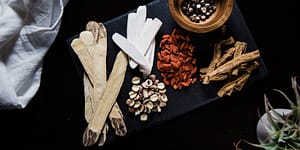Treating Addiction: From Opium Poppy to Morphine to Naltrexone

LDN, originally prescribed in higher doses as a treatment for opioid addiction, works by blocking opioid receptors, thereby stimulating the production of endorphins, mitigating the inflammatory process, and stabilizing the immune response. Prescribed off-label and administered in small daily doses, this generic drug has proven useful in treating many different ailments.
This excerpt was taken from The LND Book, Volume 2 by Linda Elsegood. It has been adapted for the web.
Naltrexone belongs to a class of drugs called opioid antagonists, a relatively new class of medicines that were first formally theorized in the 1940s. Antagonists, including opioid antagonists, block the physiological activity of other drugs, as well as naturally occurring hormones, catecholamines, peptides, and neurotransmitters.
Among the first classes of antagonists to be developed were the beta-blockers, discovered by Sir James W. Black in 1964. Beta-blockers, such as propranolol, are adrenergic blocking drugs, used to control the fight or flight response in human beings. The discovery of propranolol is widely heralded as the most important contribution to pharmacology in the 20th century.1
Being able to modify endogenous biological mechanisms in a clinically relevant way was so important to medicine that in 1988 the decision was made to award Sir Black with the Nobel Prize in Medicine, not only for his development of antagonists but also for his follow-up work, which showed how blocking receptor sites (in this case adrenergic receptors) could be used for the management of debilitating conditions, including high blood pressure, angina pectoris, and heart failure.
To this day beta-blockers are the mainstay of treatment for patients with cardiac problems, preventing millions of deaths worldwide since their development, making them one of the most successful classes of drugs ever produced.2 The scientific excitement generated by the potential of receptors to treat disease led researchers to look closely at how opioid painkillers actually worked in relation to opioid receptors in the body.

Archaeologists have also uncovered many references to painkillers made from the opium poppy. Six-thousand-year-old Sumerian texts and 2,000-year-old Egyptian hieroglyphs contain similar symbols referring to gil, which, when translated into modern language, stands for “joy” and is derived from hul gil, whose pictograph is unmistakably an opium poppy.4
The Greco-Roman fascination with opium is clear in many historical records. In ancient Greece, Hippocrates (460 bc) made many medicinal treatments from herbs, including the opium poppy seed.5 Opium abuse is also widespread in every time period from which records exist.
Notably, Roman emperor Marcus Aurelius displayed many of the symptoms and side effects of opium addiction.6 The decline of the Roman Empire, which began in about ad 500, took with it many trade routes, and widespread knowledge of the opium poppy appears to have retreated to the Arab world for the next few hundred years.
The opium poppy has been cultivated in the Arab world continuously since ancient times. Records of cultivation most often point to the country now known as Iraq, previously Sumeria, with good evidence of post–Roman Empire trade networks for opium poppies and their extracts beginning to India and China in ad 800 and farther into what is now Europe by ad 1500.7
Manuscripts referring to widespread common usage of opium, both medicinal and recreational, start to appear more regularly in the historical record from ad 1500 onward.8 Paracelsus, a Swiss doctor often heralded as the father of modern medicine, first standardized an alcoholic extract of the opium poppy, known as laudanum, in 1527.9
This standardized laudanum has been in use right up to the modern era, with the first branded laudanum making an appearance in England in as early as 1680.10
It is notable, and very important to the development of naltrexone, that the use of opium extracts was commonly known to result in addiction as well as death by overdose.

German pharmacist Friedrich Sertürner first isolated opium’s active component in an extract called papaverine in 1806 and named it morphine, after the Greek god Morpheus, the god of dreams.11
The discovery of a natural, active component that could be extracted and purified generated much scientific excitement. But at this stage of history, the science of receptors was nonexistent, and an understanding of how the drug worked was less important to the scientists of the day than producing stronger, more powerful versions with fewer side effects.
However, over the next 50 years it became increasingly apparent to doctors that morphine had several drawbacks, including breathing suppression, constipation, addiction, and even death by overdose. As morphine’s problems became more widely known and understood, an intense search began to find safer alternatives.
English scientist Charles Romley Alder Wright first synthesized diacetylmorphine in 1874 by chemically adding two acetyl groups to the morphine molecule, now commonly known as diamorphine or, when abused, heroin.12 Over the next few decades, many such chemical analogs of the original morphine were made, each one heralded as the “new morphine” without the side effects or drawbacks.
None of these new compounds were found to be free of side effects, and it is now known that the beneficial effects of morphine analogs are directly tied to the side effects through the same receptors.
Research continued, but during World War I (1914–1918) many developed countries found it difficult to access morphine due to disrupted trade. The lessened availability of morphine intensified the scientific search for a way to synthesize the drug. Throughout World War II difficulties obtaining morphine during the previous war were acutely remembered, but by this time another chemical took the spotlight: atropine.
At the time of the war effort, atropine was the only anti-cholinergic agent available to medics to counteract an attack with nerve gas. Since an inability to source sufficient atropine would significantly disadvantage any army, huge resources were applied to find an alternative to plant-derived atropine on both sides of the war.
It was through this intense scientific effort that a German scientist, Dr. Otto Eisleb, first synthesized a molecule that he called meperidine, in 1939. Meperidine failed to successfully replace atropine, but was soon recognized by Dr. Otto Schumann (who was working for a German chemical company, IG Farben) as a powerful analgesic, similar in action to morphine.13
The door to chemical synthesis of new drug compounds was now well and truly open, with scientific laboratories working around the clock to do so.
The next most widely known nonmorphine opioid to be discovered was 1,1-diphenyl-1 (dimethylaminoisopropyl) butanone-2, now commonly known as methadone, synthesized just a few short years later between 1940 and 1946.14

In certain circumstances this compound seemed to exert the opposite effect of morphine, reversing the latter’s negative effects. They called this compound nalorphine (chemical name N-allylnormorphine).
Weijlard and Erickson discovered that this compound actually had mixed effects: It had a slight analgesic action in animals, a bit like morphine, but when given to an animal pretreated with an overdose of morphine, the effects of the morphine (such as breathing suppression) were reversed.
This discovery presented a bit of a conundrum, as medical science did not yet understand the concept of receptors.
However, unhindered by the confusing effects of this compound, and recognizing that a drug that completely blocks the negative effects of morphine would be very useful, many laboratories and companies continued to synthesize different molecules. The first patent for a pure morphine-blocking drug was recorded in Great Britain in 1963, and in the United States in 1966.16 The discovered compound was naloxone.
Naloxone was a panacea for opioid overdose. Upon intravenous injection, it appeared to immediately block all effects of morphine. More than 50 years later, naloxone is still on the World Health Organization’s international list of essential medicines.17
More important to the background of low dose naltrexone (LDN), naloxone’s discovery led to other researchers discovering, in 1967, an analog that could be taken orally named Endo 1639A.18 Endo 1639A is now commonly known as naltrexone.
- M. P. Stapleton, “Sir James Black and Propranolol. The Role of the Basic Sciences in the History of Cardiovascular Pharmacology,” Texas Heart Institute Journal 24, no. 4 (1997): 336–42.
- M. D. Kertai et al., “A Combination of Statins and Beta-Blockers Is Independently Associated with a Reduction in the Incidence of Perioperative Mortality and Nonfatal Myocardial Infarction in Patients Undergoing Abdominal Aortic Aneurysm Surgery,” European Journal of Vascular and Endovascular Surgery 28, no. 4 (October 2004): 343–52.
- M. J. Brownstein, “A Brief History of Opiates, Opioid Peptides, and Opioid Receptors,” Proceedings of the National Academy of Sciences USA 90, no. 12 (June 1993): 5391–93.
- Reginald L. Campbell and R. Everett Langford, “Brief History of Substance Abuse,” in Substance Abuse in the Workplace (Boca Raton, FL: Lewis Publishers, 1995).
- Campbell and Langford, “Brief History of Substance Abuse.”
- J.M. Scott, The White Poppy: A History of Opium (NewYork: Funk & Wagnalls, 1969).
- India: S. C. Dwarakanath, “Use of Opium and Cannabis in the Traditional Systems of Medicine in India,” Bulletin on Narcotics 17, no. 1 (1965): 15–19; China: J. Fort, “Giver of Delight or Liberator of Sin: Drug Use and ‘Addiction’ in Asia,” Bulletin on Narcotics 17, no. 3 (1965): 1–11.
- Brownstein, “A Brief History of Opiates.”
- Hearne and Van Hout, “‘Vintage Meds’: A Netnographic Study of User Decision-Making, Home Preparation and Consumptive Patterns of Laudanum,” Substance Use & Misuse 50, no. 5 (April 2015): 598–608.
- Hearne and Van Hout, “‘Vintage Meds.’”
- F.W.A. Sertürner, “Darstellung der Reinen Mohnsäure (Opiumsäure), Nebst Einer Chemischen Untersuchung des Opium,” J. Pharm. f. Artze. Apoth Chem. 14 (1806): 47–93.
- J. Sawynok, “The Therapeutic Use of Heroin: A Review of Pharmacological Literature,” Canadian Journal of Physiology and Pharmacology 64, no. 1 (January 1986): 1–6.
- M. C. Michel, “An Anthology from Naunyn-Schmiedeberg’s Archives of Pharmacology,” Naunyn-Schmiedeberg’s Archives of Pharmacology 373, no. 2 (May 2006): 139.
- C. C. Scott and K. K. Chen, “The Action of 1,1-diphenyl-1-(dimethylaminoiso-propyl)-butanone-2, a Potent Analgesic Agent,” Journal of Pharmacology and Experimental Therapeutics 87, no. 1 (May 1946): 63–71.
- S. Hosztafi, T. Friedmann, and Z. Furst, “Structure-Activity Relationship of Synthetic and Semisynthetic Opioid Agonists and Antagonists,” Acta Pharmaceutica Hungarica 63, no. 6 (November 1993): 335–49.
- Sankyo Co., New morphinone and codeinone derivatives and process for preparing the same, GB Patent 939287 A, filed March 9, 1962, and issued October 9, 1963; M. J. Lewenstein, Morphine derivative, US Patent 3254088, filed March 14, 1961, and issued May 31, 1966.
- “Essential Medicines,” World Health Organization, http://www.who.int/medicines /services/essmedicines_def/en.
- Endo Lab, 14-hidroxydihydronormorphinone derivatives, filed December 6, 1966, and issued July 25, 1967.
Recommended Reads
Recent Articles
Learning how to ask questions that will elicit relevant information is as much an art form as creating an herbal formula. Follow this broad list as a starting point.
Read MoreWant to start your own medicinal herb garden? Passionflower, lemon balm, and goldenseal are great places to begin! These herbs are jam-packed with medicinal properties and easy to grow in a majority of climates.
Read MoreSprouts are easy to cultivate, mature quickly and pack a nutritional punch! You can make nutrient-rich sprouts from all kinds of edible seeds in your kitchen.
Read MoreSuffering from frequent headaches is miserable and immobilizing. If you haven’t had luck treating and preventing your headaches, skip the over-the-counter approach and prepare herbal formuals for migraines to use in the future! The following is an excerpt from Herbal Formularies for Health Professionals, Volume 4 by Jill Stansbury. It has been adapted for the…
Read More








